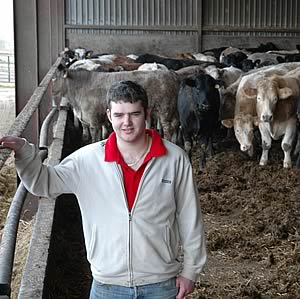29/04/08
Twenty year old George Harrison is optimistic for the future. While he is among a fast diminishing number of young farmers planning a future in livestock, he does believe that the future for beef and lamb is bright, a view shared by both UK and global farming leaders, as the new issue of food security begins to impact.
George Harrison
 |
“Okay, cereal and fertiliser prices have soared in the last six months, however we have seen a recent hike in livestock market prices, and it’s the medium to long term I’m looking towards,” he said.
“There’s going to be a shortage of cattle not only in the UK, but also in Europe while supermarkets continue to screw down consumer prices. It’s not just environment security but also food security that is now just being recognised in Brussels as an issue for the next 50 years.
“That’s where we come in; for example we’re experienced in producing volumes of fast finishing Charolais cross cattle cost effectively and that fit with current market requirements.”
George is the third generation to continue managing one operation within the Harrison family’s diverse business established by his grandfather, Alan, ranging from concrete construction, and recycling to haulage and storage.
“I enjoy farming and the range of different activities that’s involved, and I like being a member of the family team,” he says.
The Harrison family farms more than 2,000 acres in total which includes Hill House, Wigton a 300 acre unit run by George and his father, William; his aunt, Judith and uncle, Joseph manage 400 acres at nearby Hards Farm, while his uncle, Dave runs a further 300 acres at Goodyhills.
Between the mixed farms they carry a 600 suckler cow enterprise where all progeny apart from heifers selected for replacement purposes, are taken through to finishing at Hill House, along with a further 150 bought in stores annually.
The beef enterprise is complemented by a 700 ewe flock with all lambs finished apart from those for replacements.
As far as the beef enterprise is concerned, the family has adopted a low input, high output strategy with the male calves which are kept entire, taken through to over 650kg target weight within 14 months, while heifers are finished to over 600kg on a more extensive, low cost system before 24 months of age.
The Harrisons bought their first Charolais bull to run with the suckler herd back in 2004. “He left us with a cracking set of calves, in fact we were so impressed that we’ve since bought a second one. We’ll try any breed of animal here that is going to improve the unit’s performance, and if it works, then we stick by it.
“We’re all looking for those decent calves, ones that will grow fast, with good conformation and that are quiet to work with; and we’re found that our Charolais crosses are fitting the bill. They are achieving higher performance over our other continental crosses and they’re among the top entries at Wigton mart.”
Finished cattle from Hill House are not only among the day’s top 10% of market prices at Wigton - they can also be found winning the silverware.
Towards the end of last year, several Harrison bred cattle were among the tickets at Wigton’s primestock show for Charolais sired cattle, while the cream of the crop, an 18 month old Charolais cross heifer tipping the scales at 650kgs liveweight, was awarded the major title and was among the leading prices at 173p/kg.
Hill House cattle are finished on least cost forage based diets to maximise performance. “We try to grow virtually everything we feed,” George said.
“For example 15 years ago, we were among the first to grow maize in this area and without using plastic. Its not just a good break crop for mopping up FYM, it’s a great high energy, cost effective forage.”
Forage maize is introduced to a total mixed ration comprising grass silage and whole crop wheat, home grown cereals, supplemented with molasses.
To the future, he says there’s every possibility the beef unit could be expanded to meet with forecast demand. “Increasing stock numbers is never out of the question; we may put on more suckler cows, or buy in more stores to finish.
“Whatever, we’ll always continue to strive to improve our efficiency and that will include a breeding strategy featuring Charolais as the herd’s terminal sire.”
 Roofed Midden Brings Benefits All Round Roofed Midden Brings Benefits All Round
 New Cattle Shed Improves Viability of Lake District Farm New Cattle Shed Improves Viability of Lake District Farm
 New Sheep Housing Provides Ideal Environment New Sheep Housing Provides Ideal Environment
|



